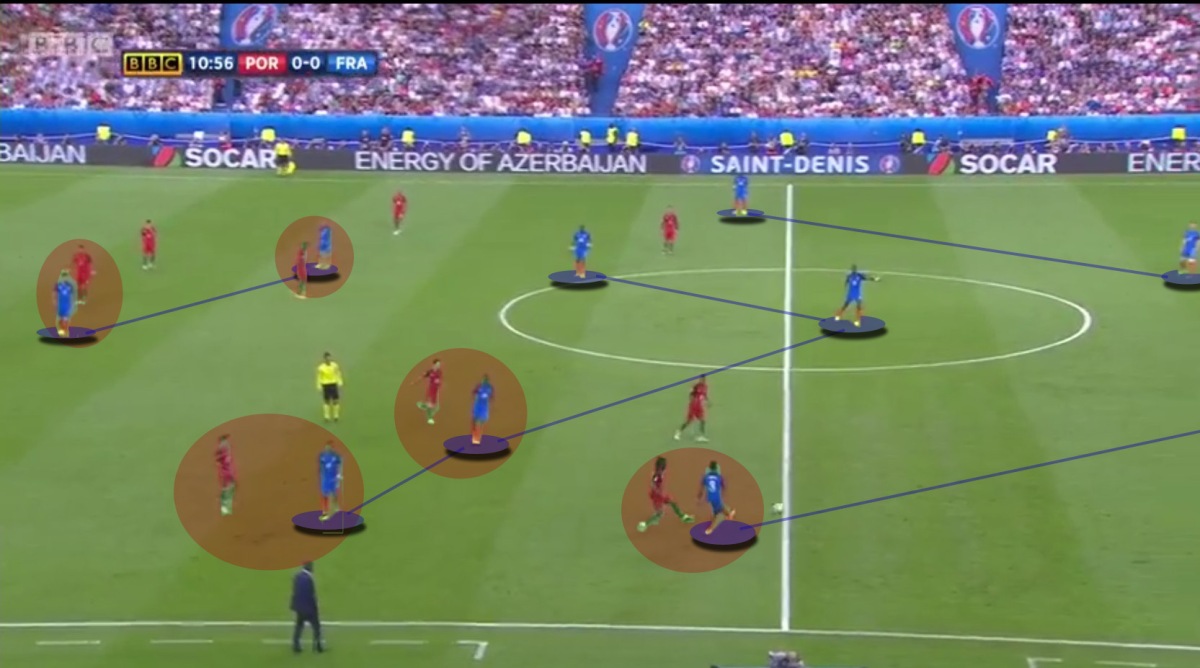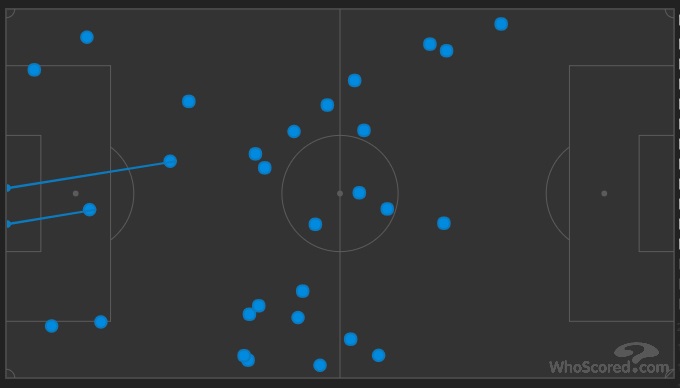Second extra time decided the winner of EURO 2016 when Eder struck a long shot into the bottom corner to clinch it for Portugal against hosts France after a long fought battle that was tactically won by Portugal. While France made no changes going into the final they were favourites to win, Portugal was lucky to have Pépé back who recovered from injury and replaced Bruno Alves that played semi final game. William Carvalho came back from suspension and replaced Danilo Pereira in defensive midfielder role.
Despite being labelled as favourites, France changed little compared to semi final match they won against Germany. Didier Deschamps set his team to defend their own half and showed no desire to risk defensive compactness by pressing high up the pitch. Nani and Cristiano Ronaldo who are both pacey and skilled on the ball were also in favour of this decision as high pressing means high defensive line which could leave a lot of space for Portugal front two to exploit.
Going forward, France again didn’t change their approach. They were largely relying on individual skill of Dimitri Payet and Antoine Griezmann ability to combine and create something for themselves or their team mates. Either Giroud and Sissoko, who was often coming inside, or Evra overlapping Payet. Matuidi and Pogba were very conservative and kept back most of the time making an odd forward run.
Initially Portugal was under a lot of pressure. More due to importance of the game than French involvement. They were misplacing passes and making unforced errors while Blaise Matuidi and Sissoko were reading the game really well taking the misplaced passes. Below you can see how high France was able to intercept the ball or win the tackle in the first half, and most of those turnovers Portugal made during initial 15 minutes of the match.

Portugal were obviously impressed and lacked their defensive cohesion as well. Below you see France attacking and Payet free on the ball. Despite Cristiano Ronaldo failed to track back and Portugal defence is pulled out of shape, Payet is lacking passing options due to France being reluctant to push Matuidi or Pogba forward.

This passive approach meant that despite numerous mistakes by Portugal players, France wasn’t able to make their domination count in the opening stage. Once Portugal managed to find the rhythm to their defensive positioning everything looked even worse for France as you see on the image below.

As Nani and Cristiano Ronaldo dropped behind the ball there was no passing lanes left open for France since they were often with at least four or five players minding possible counter attack more than attacking themselves. This was broken only when Sissoko or Matuidi drove forward with the ball at feet. However, Portugal always had a spare man to tackle or put attackers off balance.
French plan to create something was mainly down to movement. Payet and Sissoko often moved centrally while Evra, and less so Sagna, overlapped le Griezmann went deeper. However, Portugal stood firmly and their players didn’t let opponents drag them out of position.
As France failed to score in opening minutes when Portugal looked unable to cope with pressure, a major incident happened as Cristiano Ronaldo had to leave the field due to knee injury. This was turning point in the match as, instead of crumbling without their leader, Portugal rallied themselves in spite the trouble and kept plugging.
Once Cristiano Ronaldo was substituted with Quaresma Fernando Santos made an important change. Renato Sanches went into center of midfield letting Quaresma on right wing while Nano was left up front alone. This meant Portugal changed to 4-1-4-1 while defending meaning Joao Mario on left and Quaresma on right would track back following French full backs and letting Cèdric to man mark Payet and following him into center midfield where he was taken over by extra man Portugal had in center of the pitch.
This meant France had even tougher time getting into decent position to threaten Rui Patricio. In meanwhile, Portugal got foothold on the match and was mainly oriented to quick direct passes forward. Whenever Rui Patricio got his hand on the ball he was looking for an option of quick pass to catch France out of position. While this didn’t really allow Portugal to get into threatening position, it did put a pressure on France and made them unwilling to commit more players forward.
By the time first half ended, Portugal was more convinced they might come out with a win and all possession and chances France created from individual efforts dwindled down into a stalemate.
While Portugal didn’t change anything, France came back from dressing room looking to press higher and finally score. However, their pressing was largely uncoordinated as they were still sitting deep. You can see below how lonely are Griezmann and Giroud as midfield doesn’t have time to arrive and press the man since their starting position is too deep for high pressing to be effective.

Apart for (ineffective) high pressing, Didier Deschamps changed little in his approach to attack on the ball. In meanwhile, Portugal was tiring France forwards who were chasing the ball whenever it was in vicinity. Rarely in their grasp, though. Bellow you can see Portugal frustrating their opponents as creative Payet was tracked into half space by Cedric who effectively cancelled him out of the game.

However, Quaresma isn’t paying attention and Evra gets behind his back to pick a long pass from Matuidi. This forces Cedric to abandon Payet as he tracks Evra’s run and Portuguese defence collapses. This was only thing that worked really well for France and one has to ask himself if Deschamps should have exploited Quaresma’s defensive awareness more and focus attacks down right.
However, Deschamps did substitute Payet for Coman who proved to be most dangerous man in French line up during the rest of the game and Griezmann failed to convert his ideally served cross. Other opportunities he created were largely due to individual effort instead of systematic exploit of Quaresma’s defensive weakness.
Slowly through second half game changed and final move from Fernando Santos was to introduce Eder in place of Renato Sanches. He changed his shape once more and shifted to 4-3-3, although, without the ball it was old same 4-1-4-1. Also, this meant Quaresma went to left wing and Coman had to deal with Nani who’s work rate is much higher compared to Quaresma’s.
More importantly, once on the pitch, Eder was able to cope with strong and tall French midfielders Matuidi and Pogba. This gave Portugal a focal point, target man, up front who was able to hold the ball allowing his team mates to join the attack.
Once Portugal was able to get on the ball more consistently, French defensive weakness showed again. Just as Germany was able to pass through French lines, Portugal could do the same once they had ability to hold the ball.
As the match was getting ever deeper into the extra time France seemed like they stopped believing they could win and just hoped, while Portugal went the opposite way until Eder got on the ball in 109th minute to strike it into the bottom of Lloris’ net. Although he was close, Sissoko didn’t even come near to close him down and help his defenders. He was rather hoping Eder will miss instead of believing he could stop him.
To conclude, Portugal played as they did whole knock out phase. They covered the back with discipline, energy and a bit of luck while they tried to score on quick counter attack. It was really France who should have thought the plan to break them. However, beside individual efforts, that served them well together with luck, they showed little team effort to overcome determined Portugal. Deschamps had no real plan how to break them and even reacted poorly as he failed to exploit poor defending from Quaresma. On the other hand Fernando Santos seemed to pick all the right cards. He marked closely Payet and had Carvalho always near Griezmann. Once France got under the pressure he added to it even more introducing a strong striker who relieved his defence and in the end managed to score.



















